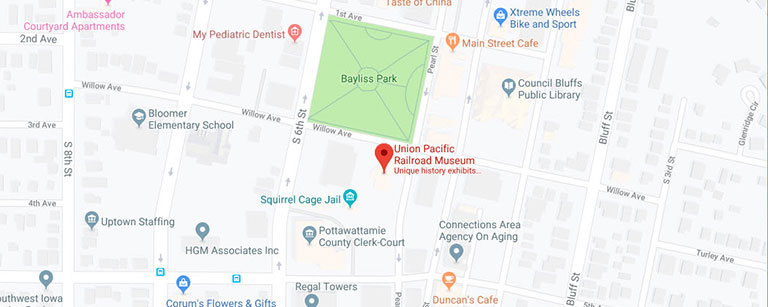Check out our collection of stories centered around the railroad
- The Not so Wild West: Firearm Regulation on the Union Pacific Railroad
When most people think about the Wild West, they think about the gun slinging cowboys and action heroes in a Hollywood Western. This vision of the West, however, did not come into existence until the early 20th century, encouraged by sensationalized dime store novels that later inspired Hollywood movies like the John Wayne Westerns. In reality, firearms were often regulated in Western towns and along the railroads. New evidence from the museum’s archives indicates that as early as 1880, Union Pacific and Central Pacific had regulations limiting how passengers could transport firearms on board trains.
- On Track and On Time: Employee Timetables
Timetables are some of the most important historical documents created by the railroad. They were designed to help station agents, employees and passengers know when a train should be departing and arriving. To ensure employees knew which trains should be stopping at their stations; timetables are set up in columns.
- The Origin of the Blue and White Striped Engineer's Cap
The origins of the engineer's cap.
- Authentic or Not: Spittoon Edition
Due to the widespread use of chewing tobacco in the 19th century, spittoons were a common fixture in public areas, including railroad stations. Their intended purpose was collecting tobacco juice spit from a distance; so typically, they were built heavy and low to the ground, with a wide mouth or funneled top. Sometimes, these rugged fixtures were enameled, but most importantly, they had to be durable and hard to tip over if kicked or shoved.
- Union Pacific and the Pawnee Scouts
Did you know that in 1864, several hundred Pawnee warriors joined forces with the U.S. Army? Friendly to the American government and bitter enemies of the Sioux, the Pawnee worked alongside the Army to protect Union Pacific as the railroad progressed into the Great Plains.
- Time is of the essence... or the railroad?
In 1809, 1870 and 1872, Congress considered and rejected calls to establish national standard time. Needing a more organized method of keeping time, railroads in the United States and Canada took the matter into their own hands.
- Union Pacific's Firearm Collection
The Union Pacific Railroad Museum's firearm collection displays over a century of unique firearms.
- The Summit Tunnel
While Central Pacific constructed 15 tunnels through the Sierra - five on the west slope, one at the summit, and nine on the east slope, the longest, and most challenging, was the Summit Tunnel.
- Digitizing Union Pacific's Past
Union Pacific Railroad Museum has embarked on a multi-year effort to digitize much of Union Pacific’s historic photograph collection.
- Footprint in Time
One of the many objects on display at the museum is something you may not expect, it's a dinosaur footprint from some 89 to 65 million years ago!
- Union Pacific’s Gold Coast Baseball Team of 1929
The 1920s saw an insurgence of family oriented initiatives within Union Pacific. Union Pacific employees created teams and leagues in various sports, including baseball, and competed with each other and in their communities.
- Streamlined China
Railroads recognized very early that dining was a key way to distinguish themselves from competitors. Passengers benefited from each railroad's effort to offer the best food, best service and best dining environment.
- Calumet Pipe
A calumet, from the French word chalumet, meaning reed or flute, is a profoundly sacred object to many Native American tribes.
- Theodore Judah's Golden Ring
A treasured artifact from the Union Pacific Historical Collection has recently come to light after being in the Washington D.C. office for more than a decade without any real attention to its unique provenance and history.
- Death of Union Pacific night watchman, Jess Sitton, Cheyenne, Wyo., 1922
Some artifacts tell a story just by looking at them. One the most powerful pieces in the Union Pacific Historical Collection is a 1920s railroad police badge worn by Cheyenne, Wyo., Agent Jess Sitton.
- The Ames Monument
Located about 20 miles east of Laramie, Wyo., the Ames Monument was erected at what was once the highest elevation on Union Pacific's line, Sherman Summit.
- Carnegie Library to World Class Railroad Attraction
The Union Pacific Railroad Museum turns 10 in a 110 year old Library
- Union Pacific's A.J. Russell Collection
Among the many photographers represented in Union Pacific's vast photography collection, one of the earliest and more prolific was Andrew J. Russell.
- General Samuel Curtis Uniform Coat and Epaulettes
The Uniform coat pictured here, is an Officers Dress Tail Coat and was worn by Curtis when he served as a Colonel of the Third Ohio Volunteer Infantry during the Mexican War.
- Lincoln’s Rocking Chair
This chair is originally from the law office of Lincoln and Herndon in Springfield, Ill., where Lincoln practiced law from 1843 to about 1852.

